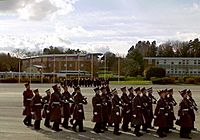Scots Guards facts for kids
Quick facts for kids Scots Guards |
|
|---|---|
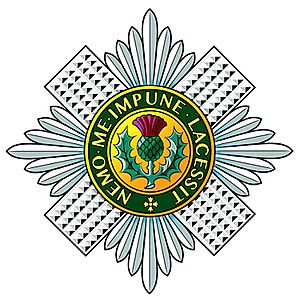
Regimental badge of the Scots Guards
|
|
| Active | 1642–1651 1662–present |
| Country | Kingdom of Scotland (1642–1651) Kingdom of England (1662–1707) Kingdom of Great Britain (1707–1800) United Kingdom (1801–present) |
| Branch | British Army |
| Type | Foot Guards |
| Role | 1st Battalion Scots Guards – Mechanized Infantry F Company – Public Duties |
| Size | One battalion – 707 personnel One company One reserve company |
| Part of | Guards Division |
| Garrison/HQ | RHQ – London 1st Battalion – Catterick F Company – London G (Messines) Company – Army Reserve, London |
| Nickname(s) | The Kiddies; Jock Guards |
| Motto(s) | "Nemo Me Impune Lacessit" (Latin) "No one assails me with impunity" |
| March | Quick – "Hielan' Laddie" Slow – "The Garb of Old Gaul" |
| Anniversaries | St Andrew's Day Nov 30 Battle of Mount Tumbledown Jun 13 |
| Commanders | |
| Colonel-in-Chief | The King |
| Colonel of the Regiment |
The Duke of Kent KG GCMG GCVO CD ADC |
| Insignia | |
| Tactical Recognition Flash |  |
| Tartan | Royal Stewart (Pipers kilts, Trews and Plaids) |
| Plume | none |
| Abbreviation | SG |
The Scots Guards (SG) is one of the five Foot Guards regiments in the British Army. It started as the personal bodyguard for King Charles I of England and Scotland. The regiment's history goes back to 1642.
Contents
The Scots Guards Story
How it Started: 17th Century
The Scots Guards began in 1642. It was first known as the Marquis of Argyll's Royal Regiment. This unit was created by Archibald Campbell, 1st Marquess of Argyll. He formed it to respond to a rebellion in Ireland.
Later, in 1660, King Charles II allowed a new regiment to be formed. This was called The Scottish Regiment of Footguards. It helped put down the Covenanter rising in 1679. It also fought in Argyll's Rising in 1685. After this, it grew to have two main groups called battalions.
When the Nine Years War started in 1689, one battalion went to Flanders. The other fought in Ireland at the 1690 Battle of the Boyne. Both groups then joined up and fought in battles like Steenkerque and Landen. They also took part in the Siege of Namur in 1695. After the war ended in 1697, the regiment returned to Scotland.
18th Century Adventures
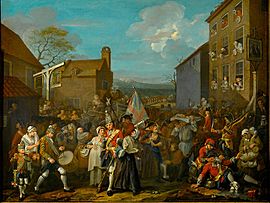
The Guards stayed in Scotland during the War of the Spanish Succession. In 1712, they were renamed The Third Regiment of Foot Guards. They then moved to London and did not return to Scotland for a long time.
During the War of the Austrian Succession (1740-1748), the First Battalion fought in battles like Dettingen in 1743. They also fought at Fontenoy in April 1745. This was a famous British defeat where the French and British Guards invited each other to shoot first.
Both battalions were in London during the 1745 Rising. An old picture by William Hogarth shows them marching to defend North London. However, the Jacobite army turned back. In 1747, the Second Battalion went to Flanders. There, they fought at Lauffeld before the war ended.
In the past, the army often helped control crowds. In 1768, a group from the "Third Regiment of Guards" helped break up a crowd. This crowd was trying to free a politician named John Wilkes from prison.
19th Century: Peninsular War and Waterloo
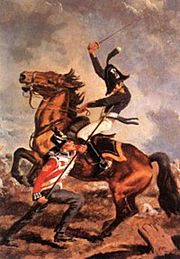
In 1809, the 1st Battalion went to Portugal and Spain. They fought in the Peninsular War. They helped cross the River Douro in May, which led to the French army retreating. In July 1809, the regiment fought in the Battle of Talavera. This was one of the toughest battles of the war.
The 2nd Battalion also took part in the Walcheren Campaign in the Netherlands. The 1st Battalion continued to fight in many important battles. These included the Battle of Fuentes de Oñoro in 1811 and the Battle of Salamanca in 1812. They also helped in the Siege of San Sebastián in 1813 and the Battle of the Nive in 1813.
At the famous Battle of Waterloo in June 1815, the Scots Guards were positioned behind Hougoumont. Their light companies, led by Lieutenant-Colonel James Macdonnell, bravely held Hougoumont Farm. This farm was a very important defensive spot during the battle.
World Wars and Beyond
First World War (1914-1918)
The 1st Battalion arrived in France in 1914 as part of the British Expeditionary Force. They fought in the Battle of Mons in August 1914. They also took part in the First Battle of the Marne and the First Battle of the Aisne in September 1914.
Both the 1st and 2nd Battalions fought in the First Battle of Ypres in November 1914. They were also in the Battle of Aubers Ridge in 1915 and the Battle of Loos in 1915. In July 1916, the Scots Guards fought in the first Battle of the Somme. In 1917, they were involved in the Battle of Passchendaele. In 1918, they fought at the second Battle of the Somme. They also took part in the final battles on the Western Front.
Second World War (1939-1945)
In April 1940, the 1st Battalion went to Norway for its first campaign of the war.
In North Africa, the 2nd Battalion fought against Italian forces in Egypt and Libya. In March 1943, the 2nd Battalion helped defend against German attacks in the Battle of Medenine.
In September 1943, the 2nd Battalion landed at Salerno in Italy. In December 1943, the 1st Battalion arrived in Italy. At the Battle of Monte Cassino in early 1944, the 2nd Battalion faced very tough fighting and had many losses.
The 1st Battalion joined the 6th South African Armoured Division in May 1944. The regiment fought in many fierce battles throughout 1944. This included fighting against the strong Gothic Line defenses.
After 1945
After the Second World War, the Scots Guards served in several conflicts. In 1948, the 2nd Battalion went to Malaya (now Malaysia). They helped stop a Communist uprising during the Malayan Emergency. They guarded areas, patrolled jungles, and fought against rebels.
By late 1951, the 1st Battalion was sent to Cyprus. In 1952, they moved to the Suez Canal Zone in Egypt. In 1962, the 2nd Battalion went to Kenya to help during the Mau Mau Uprising. In 1965, the 1st Battalion served two tours in Borneo during the Indonesian Confrontation.
Both battalions also served in Northern Ireland during the Troubles in the early 1970s.
During the Falklands War in 1982, the Scots Guards advanced on Mount Tumbledown. In the early hours of June 14, 1982, soldiers from the 2nd Battalion bravely charged the Argentinian defenders. This was a very tough fight and one of the last bayonet charges by the British Army.
In 2004, the 1st Battalion went to Iraq for six months. They were part of a British-led force.
In 2021, the 1st Battalion moved to Catterick Garrison. In 2022, a company of soldiers joined the Scots Guards. This company became G (Messines) Company.
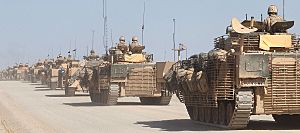
Regimental Traditions
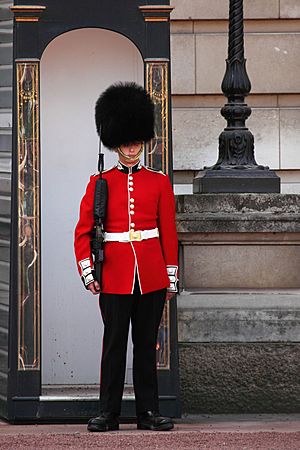
The Scots Guards and other Guards regiments have a special link to the Parachute Regiment. Guardsmen who pass a tough selection course can join the Guards Parachute Platoon. This group is part of the 3rd Battalion, Parachute Regiment.
The Scots Guards are the third regiment in the Guards Division. You can spot Scots Guardsmen by the buttons on their tunics. They are spaced in groups of three.
How the Regiment Works
Since 1993, F Company has been based in London. They perform "public duties," like guarding royal palaces. This company keeps the traditions of the 2nd Battalion alive. The 2nd Battalion was put on hold in 1993.
The regiment has one main battalion that is ready for action. This 1st Battalion is based in Catterick. They are equipped with Warrior Vehicles and will later use Mechanised Infantry Vehicles. The 1st Battalion does not rotate for public duties; F Company handles that role.
A company from the London Regiment also joined the Scots Guards. This company is now called G (Messines) Company.
Training to be a Scots Guard
New recruits for the Guards Division go through a 30-week training program. This happens at the Infantry Training Centre (ITC). This training is two weeks longer than for other army regiments. The extra time is spent learning special drills and ceremonies.
Important Leaders
Colonels-in-Chief
King Edward VII became the Colonel-in-Chief when he became king. All kings and queens since then have also held this special role.
Regimental Colonels
Many important people have been Regimental Colonels, including:
- 1664: Major-General George Livingston, Earl of Linlithgow
- 1684: Lieutenant-General James Douglas
- 1691: Lieutenant-General George Ramsay
- April 1707: Lieutenant-General William Kerr, Marquess of Lothian
- 1713: General The Earl of Dunmore
- 1752: General The Earl of Rothes
- 1767: Field Marshal The Duke of Gloucester
- 1770: General The Earl of Loudoun
- 1782: Field Marshal The Duke of Argyll
- 1806: Field Marshal The Duke of Gloucester
- 1834: General The Duke of Gordon
- 1836: General The Earl Ludlow
- 1842: Field Marshal Prince Albert of Saxe-Coburg and Gotha
- 1852: General The Duke of Cambridge
- 1861: Field Marshal Sir Alexander Woodford
- 1870: General Sir John Aitchison
- 1875: General The Lord Rokeby
- 1883: General Sir William Knollys
- 1883: Field Marshal The Duke of Connaught and Strathearn
- 1904: Field Marshal The Lord Methuen
- 1932: General The Duke of York
- 1937: Field Marshal The Duke of Gloucester
- 1974: Field Marshal The Duke of Kent
Battle Honours
Battle honours are special awards given to military units for their bravery in battles. The Scots Guards have earned many of these honours:
- Before First World War: Namur 1695, Dettingen, Lincelles, Egypt, Talavera, Barrosa, Fuentes de Oñoro, Salamanca, Nive, Peninsula, Waterloo, Alma, Inkerman, Sevastopol, Tel-er-Kebir, Egypt 1882, Suakin 1885, Modder River, South Africa 1899–1902
- First World War:
- Western Front: Retreat from Mons, Marne 1914, Aisne 1914, Ypres 1914 1917, Langemarck 1914, Gheluvelt, Nonne Bosschen, Givenchy 1914, Neuve Chapelle, Aubers, Festubert 1915, Loos, Somme 1916 1918, Flers–Courcelette, Morval, Pilckem, Poelcapelle, Cambrai 1917 1918, St. Quentin, Albert 1918, Bapaume 1918, Arras 1918, Drocourt-Quéant, Hindenburg Line, Havrincourt, Canal du Nord, Selle, Sambre, France and Flanders 1914–18
- Second World War:
- North-West Europe: Stien, Norway 1940, Quarry Hill, Estry, Venlo Pocket, Rhineland, Reichswald, Kleve, Moyland, Hochwald, Rhine, Lingen, Uelzen, North-West Europe 1944–45
- North Africa: Halfaya 1941, Sidi Suleiman, Tobruk 1941, Gazala, Knightsbridge, Defence of Alamein Line, Medenine, Tadjera Khir, Medjez Plain, Grich el Oued, Djebel Bou Aoukaz 1943 I, North Africa 1941–43
- Italy: Salerno, Battipaglia, Volturno Crossing, Rocchetta e Croce, Monte Camino, Campoleone, Carroceto, Trasimene Line, Advance to Florence, Monte San Michele, Catarelto Ridge, Argenta Gap, Italy 1943–45
- After World War II: Tumbledown Mountain (Falkland Islands 1982), Gulf 1991
Alliances
 Australia – 3rd Battalion, Royal Australian Regiment
Australia – 3rd Battalion, Royal Australian Regiment Royal Navy – HMS Duncan
Royal Navy – HMS Duncan
Freedom of Entry
- The town of Wantage gave the Scots Guards the special right to march through its streets on August 2, 2010.
Order of Precedence
| Preceded by Coldstream Guards |
Infantry order of precedence | Succeeded by Irish Guards |



